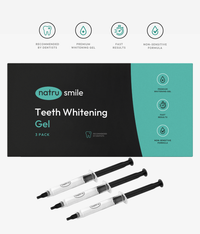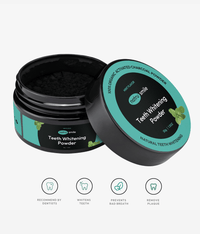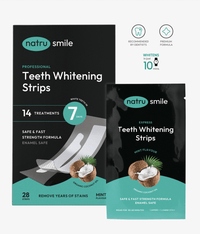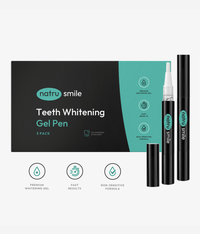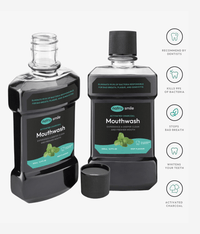
All products are certified by dental expert Dr. Greg Grillo
Whitening toothpaste is one of the most popular and accessible teeth whitening options. Available just about anywhere you can purchase regular toothpaste, whitening toothpaste contains additives that whiten your teeth.
But do they actually work?
The answer to this depends on the type of toothpaste you use and the duration you use it for.
In this article, we'll tell you everything you need to know about whitening toothpaste.
How Effective Is Teeth Whitening Toothpaste?
To put it briefly, whitening toothpaste has been proven to be effective in numerous studies over decades. But the results it produces won't be as vibrant or long-lasting as those from a professional whitening treatment.
But to understand the extent to which it works, we first need to look at the ingredients and how they help to whiten teeth.
Most whitening toothpaste contains abrasive and bleaching components, such as silica, pyrophosphates, baking soda, hydrogen peroxide, or carbamide peroxide, that work together to eliminate surface stains, resulting in a brighter shade of teeth.
These agents work by physically scrubbing away stains caused by food, drinks, and tobacco that have built up on the enamel over time.
How effective they are at doing so, however, depends on the type and severity of stains on your teeth.
If you have mild surface stains from coffee, tea, or red wine, whitening toothpaste may help reduce their appearance and brighten your teeth over time.
But if you have deep stains from years of bad habits (e.g., smoking) or poor dental hygiene, whitening toothpaste may not be strong enough to make a difference.
Note: Some types of whitening toothpaste result from fads and offer no real benefit. Stay away from any toothpaste that contains turmeric, charcoal, or other whiteners that won't work.
Getting The Most From Your Whitening Toothpaste
If you decide to give whitening toothpaste a try, there are a few things you can do to maximize its effectiveness:
- Brush twice each day. Brushing your teeth twice a day with whitening toothpaste is crucial for maintaining your oral health and achieving maximum whitening results. This will help to remove surface stains and prevent new ones from forming.
- Be gentle. While the abrasive agents in whitening toothpaste are effective in removing surface stains, they can also wear down your enamel if you brush too hard. Be gentle when brushing your teeth and use a soft-bristled toothbrush to avoid damaging your teeth and gums.
- Wait before rinsing. After brushing your teeth with whitening toothpaste, avoid rinsing your mouth with water right away. Leave the toothpaste on your teeth for a few minutes to allow the active ingredients to work their magic.
- Don't overuse it. Whitening toothpaste should not be used too often as it can cause tooth sensitivity and enamel erosion. Follow the manufacturer's instructions and use it in moderation. These teeth whitening products should never be used for more than four to six weeks at a time.
- Avoid staining foods and drinks. To maintain the whiteness of your teeth, try to avoid foods and drinks that can cause stains, such as coffee, tea, red wine, and dark-colored fruits and vegetables.
What’s Different About Teeth-Whitening Toothpaste?
Teeth whitening toothpaste is specially formulated with abrasive and bleaching agents that work together to remove surface stains and brighten the teeth.
The abrasive agents in the toothpaste, such as hydrated silica or calcium carbonate, are finely ground particles that physically scrub away stains caused by food, drinks, and tobacco that have built up on the enamel over time.
Like traditional toothpaste, fluoride is the main active ingredient—whitening toothpaste is a substitute for those who want to improve their smiles.
How Long Does Whitening Toothpaste Take To Work?
The time frame you can expect to see results with whitening toothpaste is different for everyone, depending on:
- The severity of your discoloration
- The type of whitening toothpaste you are using
- Your brushing habits
- Underlying dental issues that need to be taken care of first
Some patients see results after using whitening toothpaste just one time. But this is usually only the case if they have a history of poor oral hygiene that caused their discoloration.
Those with mild to moderate tooth discoloration generally see whitening results within a week of twice-daily use.
The Pros And Cons Of Whitening Toothpaste
Like all teeth whitening products and procedures, whitening toothpaste has a distinct set of advantages and disadvantages.
Advantages Of Whitening Toothpaste
Benefits of teeth whitening toothpaste include the following:
Cost-effective alternative to other whitening treatments
In-office whitening costs anywhere from $500 to $1,000 or more depending on the type of treatment. And since it requires one or multiple whitening sessions, it is also inconvenient for those who work during the day.
Although it is more expensive than traditional toothpaste, it is considerably cheaper than professional whitening treatments.
Compared to teeth whitening kits, toothpaste offers a lower cost option that can still deliver results.
Reduces mild surface stains from food, drinks, and tobacco
If all you need is a quick touch-up for aesthetic purposes, whitening toothpaste can do the job without damaging your enamel.
It is perfectly capable of removing surface stains that cause discoloration, and many users see slight results after just one or two uses.
Easy to use at home
Since it works into your daily brushing regimen without requiring any extra steps, it is an easy and hassle-free teeth whitening solution.
Its ease of use is especially beneficial considering the amount of work some other whitening solutions require.
Contains fluoride to prevent cavities and promote oral health
Many whitening toothpaste brands contain fluoride, which is a mineral that helps to prevent tooth decay and promote overall oral health.
Fluoride works by strengthening the enamel and making it more resistant to acid erosion and bacterial attacks.
Because fluoride is its active ingredient, all you have to do is switch it for your regular toothpaste and brush as you normally would.
Available at most grocery and drug stores
Its wide availability makes whitening toothpaste the most (and sometimes only) viable option for many people.
By simply walking into a store, you can pick up whitening toothpaste and start your teeth whitening journey right away.
This convenience makes it easy to maintain a regular oral hygiene routine with a whitening toothpaste that fits your individual needs and preferences.
Disadvantages Of Whitening Toothpaste
Drawbacks of whitening toothpaste include:
Limited effectiveness for severe discoloration
Unfortunately, its low cost and easy accessibility come with a major caveat: it doesn't work as well as most other whitening choices.
It can only remove surface stains, meaning it is generally ineffective for deeper, more severe discoloration. Genetics-related stains may also be difficult to treat with whitening toothpaste, as they often require more intensive treatments like professional teeth whitening or veneers.
Can cause tooth sensitivity and enamel erosion if overused or used too aggressively
Sensitivity is the most common side effect of teeth whitening, affecting almost everyone who uses it. It can cause temporary discomfort or even pain, especially when consuming extremely hot or cold drinks or foods.
The abrasive agents in whitening toothpaste can also wear down the enamel on the teeth, leading to potential damage. To minimize the risk of this, users must follow the manufacturer's instructions and use whitening toothpaste in moderation to avoid damaging the teeth and gums.
Requires consistent use over time to see results
While whitening toothpaste can be effective for reducing mild surface stains, it requires consistent use over time to see noticeable results. Users will often see results right away, but lasting and significant whitening will require several uses before it can be achieved.
Other steps must be taken as well—whitening toothpaste won't do much for coffee drinkers or smokers who don't change their habits.
May not be suitable for those with certain dental conditions or allergies
Some people may have underlying dental conditions or allergies that make them unsuitable candidates for using whitening toothpaste.
It's important to consult with a dental professional before using any new dental products, including whitening toothpaste.
Doesn't address underlying issues that may be causing discoloration
Discoloration has multiple causes:
- Poor dental hygiene
- Consumption of food and drinks that damage teeth enamel
- Certain medications
- Aging
- Genetics
While whitening toothpaste can help to reduce surface stains, it does not address the root cause of the discoloration and may not be effective for those with underlying issues.
What Should You Look For In Whitening Toothpaste?
Choosing the right toothpaste can be a challenge, especially when the grocery store shelves are stocked with dozens.
Here are four things to look for:
- Active ingredients: Look for whitening toothpaste that contains both abrasive and bleaching agents. Silica and calcium carbonate work to physically scrub away surface stains, while bleaching agents like hydrogen peroxide or carbamide peroxide penetrate the enamel and break down stain molecules.
- Sensitivity: Patients with sensitive teeth should look for a whitening toothpaste that is specifically formulated for sensitive teeth. These types of toothpaste typically contain lower levels of abrasive agents and may also include ingredients like potassium nitrate to help soothe and protect sensitive teeth.
- Brand reputation: Look for a whitening toothpaste brand with a good reputation for producing high-quality oral care products. Research the brand and read customer reviews to get a better sense of the product's effectiveness and overall quality.
- Price: While cost shouldn't be the only factor you consider when choosing a whitening toothpaste, it's important to find a product that fits within your budget. Compare prices between different brands and look for deals or discounts to help save money.
By considering these factors, you can find a whitening toothpaste that is effective, safe, and affordable, and helps you achieve your desired level of whiteness while promoting overall oral health.
Are There Alternatives To Teeth Whitening Toothpaste?
If you're looking for alternatives to whitening toothpaste, there are several options available:
- Professional teeth whitening treatments: If you have severe discoloration or are looking for more significant whitening results, professional teeth whitening treatments may be a better option.
- Whitening strips: Whitening strips are thin, flexible strips that are coated with a whitening gel and are applied directly to the teeth. They work by bleaching the stains on the surface of the teeth and can be an effective alternative to whitening toothpaste.
- Whitening trays: Whitening trays are custom-fitted trays that are filled with a whitening gel and worn over the teeth for a specified amount of time. They can provide more targeted and effective whitening than whitening toothpaste.
- Natural remedies: Some people prefer to use natural teeth whitening methods like oil pulling. While these methods may have some whitening properties, it's important to consult with a dental professional before using them to ensure that they're safe and effective.
- Lifestyle changes: Making changes to your lifestyle can also help to prevent and reduce teeth staining. Avoiding or limiting consumption of staining foods and drinks, quitting smoking, and maintaining good oral hygiene habits can all contribute to a brighter, healthier smile.
- Veneers: Dental veneers are thin shells that are adhered to the front of the teeth to improve their appearance. They provide a more even, uniform color and offer a more permanent (and expensive solution).
Ultimately, the best teeth whitening method for you will depend on your individual needs and preferences. Consult with your dentist to determine which option is right for you.
Is Teeth Whitening Toothpaste Right For You?
Whether or not you will truly benefit from this teeth whitening method depends on several factors:
- Willingness to wait for results: Whitening toothpaste takes time to work and isn't always the quickest method of whitening teeth.
- Overall oral health: If you have any pre-existing dental conditions or problems, consult with your dentist before using a special toothpaste.
- Budget: If cost is a concern, using whitening toothpaste may be a good way to achieve some level of whitening without breaking the bank.
- Severity of your condition: Whitening toothpaste can help to reduce minor discoloration, but if your teeth are severely stained or yellowed, you will need a more powerful whitening solution.
Thanks to its low cost and practicality, toothpaste can be a great way to maintain the brightness of your smile. In most cases, it is worth considering if you're looking to reduce minor discolorations and brighten your teeth.
The Bottom Line
When browsing the grocery store shelves for a whitening toothpaste, knowing what to look for helps you make an informed decision. Consider the whitening ingredients used, their efficacy, and their safety before purchasing.
Remember to avoid whitening toothpaste with activated charcoal. And remember that whitening toothpaste won't deliver the vibrant whitening results that more powerful solutions do.


